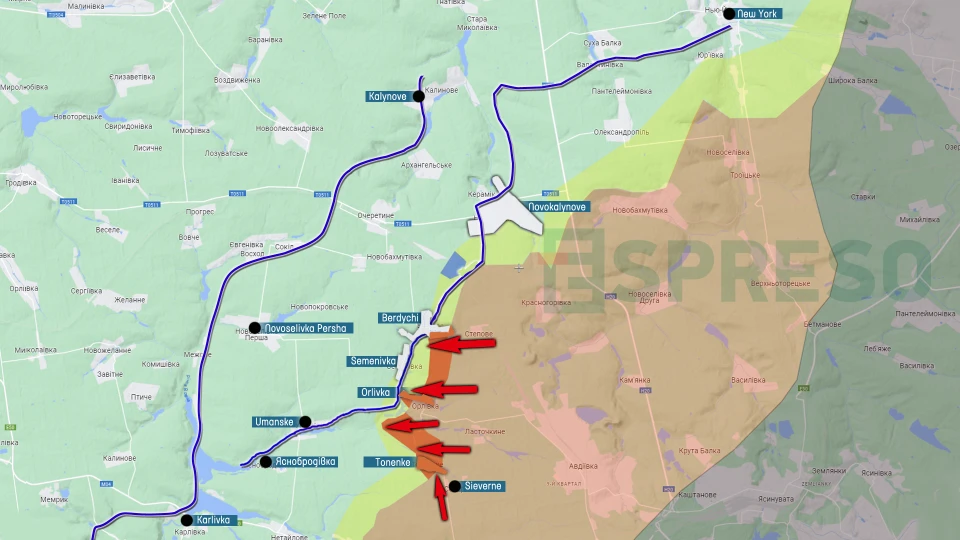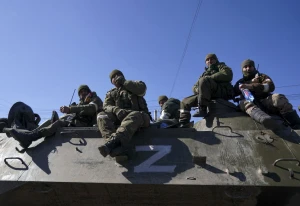
Analysis of Russia’s offensive, losses and situation in Avdiivka direction. Serhiy Zgurets’ column
New details of strikes on the temporarily occupied Sevastopol with Ukrainian Neptune missiles and the situation in the Avdiivka direction
Elimination of Russian airborne missiles with Neptune missiles
The attack on Sevastopol with high-precision weapons carried out by the Ukrainian Armed Forces on March 24 is gaining new details, indicating a positive trend in the development of domestic means of destruction. During the complex attack on Russian ships in Sevastopol, as well as on the communications and control center and airfield where Russian aircraft were stationed, French SCALP cruise missiles were used. These missiles were employed to disable the Russian large landing ships of the Black Sea Fleet Azov and Yamal.
The Ukrainian Navy later officially confirmed that during the attack on March 24 on the still-occupied Sevastopol, another large landing ship, the Konstantin Olshansky, was targeted and hit. This Ukrainian landing ship was captured by Russia in 2014 and remained stationed in the Sevastopol bay for nine years, where it was looted by Russian troops. When it became clear that their large landing ships were being destroyed, the Russians decided to restore this ship for combat missions against Ukraine. Consequently, the command of the Ukrainian Armed Forces decided that this ship should also be destroyed, leading to the decision to use the Neptune missile for the attack.
Ukrainian Navy spokesman Dmytro Palenchuk said about this large landing ship, the Konstantin Olshansky, that it was hit by a Neptune missile, and the damage is being investigated.
Neptune is the missile that destroyed the Russian cruiser Moskva in April 2022. Two RK-360MC missiles caused such damage that the ship sank near Zmiinyi Island. This incident showcased this development internationally, as the Neptune missile and the entire coastal complex were developed and created by the Kyiv Design Bureau Luch in cooperation with a dozen Ukrainian enterprises. These enterprises developed all the main elements of this system, from the homing head to the engines to the launcher itself.
So now, the Neptune strike on the landing ship in Sevastopol Bay, according to our company's experts, actually shows that the Neptune mobile coastal system used by Ukraine’s Navy has undergone significant dynamics in its development and modernization.
Firstly, let's consider the range. Originally, the Neptune missile was stated to have a range of 280 km. However, when factoring in the need to evade Russian air defense systems and the potential location of the launcher, the effective range increases significantly. This indicates that the system is now capable of firing from a greater distance and at extended ranges.
The guidance system has also seen significant improvements. Finding a target in a bay filled with numerous ships of the same type is inherently more challenging than striking a single large target like the cruiser Moskva. This indicates that Ukraine has substantially enhanced the guidance system of the missile, enabling it to select specific targets in complex environments. It underscores a notable advancement in the capability and effectiveness of this weapon system.
Now, our focus shifts to ramping up the production of these long-range systems, crucial for neutralizing enemy targets. We anticipate the next phase will involve deploying this missile against ground targets. Interestingly, there have been instances where this missile was employed to eliminate Russian air defense systems in Crimea. They used certain tricks to hit Russian air defense systems with our missile, but it worked quite effectively.
Satellite images that appeared as a result of the strikes on Sevastopol on March 24 also confirmed that in addition to the three landing ships I mentioned, the Ivan Khurs reconnaissance ship was also hit precisely. This is the kind of ship that Russia used to monitor our radar stations, the positions of any radiation systems. Russia had two such ships, one of which was attacked in the Black Sea and, I think, will not be able to perform combat functions for a long time. This attack on March 24 was very effective in terms of scale.
The situation in the Novopavlivka and Lyman directions
If we examine the report from the General Staff, there are notable indications that the dynamics are shifting. There has been a significant increase in the number of clashes in two specific areas - Novopavlivka, where Russia has persistently attempted to breach our defenses, and the Lyman direction. The latter is particularly noteworthy as clashes in this region have intensified, with reports of as many as 15 engagements in locations such as Terny, Yampolivka, and Torske. Here, Russian forces are endeavoring to dislodge our troops beyond the Zherebets River - a long-standing objective of theirs. The recent uptick in activity in this sector of the frontline suggests Russia’s renewed determination.
The situation in the Bakhmut and Avdiivka directions
Two other areas we mentioned earlier are Bakhmut and Avdiivka. There were only, relatively speaking, four combat clashes there over the past day, but this should not be reassuring, because it is a decrease in combat clashes after a rather active previous phase both in the Bakhmut direction and west of Avdiivka. We can now assess this as Russia regrouping its forces. In any case, Avdiivka remains the main focus of Russian efforts, or rather the positions west of Avdiivka, and if we look closely at the map, the fighting continues along the entire contact line.

Photo: Espreso
If we go from north to south, we will see Ocheretyne, Berdychi, Semenivka, Orlivka, Tonenke, Pervomayske, Neverske, and there are hostilities in each of these areas.
To briefly describe the situation, Orlivka is currently in a gray zone, I would say. Judging by various reports and assessments by OSINT (open source intelligence) observers who analyze photos and videos, Russia is trying to gain a foothold in Orlivka and continue to make its way to Semenivka.
In this area, the 3rd separate assault brigade is actively engaged on our side. Just recently, Commander Andriy Biletskyi highlighted that Russian forces maintain superiority in aviation, utilize UAVs, and employ artillery. Despite these challenges, the Ukrainian military continues to inflict significant manpower losses on Russian troops, who are swiftly reinforcing with reserves. While the situation remains extremely challenging, it's noteworthy that the enemy is sustaining far greater losses.
Active fighting also continues in Berdychi, north of Orlivka. The 47th Mechanized Brigade is holding the defense there, eliminating dozens of personnel, but Russia is also trying to pull up reserves, so the situation there remains extremely difficult. Fighting is also going on west of Tonenke, Russian forces have captured Tonenke, or what's left of it, and are trying to move west, but our 53rd Mechanized Brigade is striking them there.
Our artillery and drones are actively working in all these areas, although there is also significant pressure from the Russians, and the defense line is held primarily by the courage of our soldiers and the resilience of the defense using various technical means, including drones.
Losses on the battlefield
Over the last week, Russia lost at least 36 units of various military equipment west of Avdiivka, including 10 tanks and 21 infantry fighting vehicles. By the way, the number of infantry fighting vehicles has increased, as well as the losses in this category of weapons.
Ukrainian losses to the west of Avdiivka are much lower. This week, they amounted to about 10 armored vehicles - three tanks and two armored infantry fighting vehicles, the rest were automotive vehicles.
All Russian losses since October 2023 in the Avdiivka direction, when they initiated these large-scale offensives with its units and brigades, were tallied. So far, it has been determined that since October, Russia has lost a total of 857 units of various armored vehicles in this area. In contrast, the losses of the Ukrainian Armed Forces amounted to 126 units of light and medium armored vehicles. This presents a ratio of at least 1:6 in terms of military equipment.
Personnel losses: Russia reportedly lost up to 50,000 personnel during the storming of Avdiivka. However, personnel losses may not weigh heavily in Russia’s strategy, as they are viewed more as a bargaining chip.
The use of drones at the front
The recent estimates of the use of FPV drones by both Ukrainian and Russian forces for February and March have revealed an interesting trend. It appears that the number of recorded instances of accurate FPV drone usage on the Ukrainian side surpasses that of Russia’s side. This suggests a favorable dynamic regarding FPV drones for Ukraine. However, it's important to consider that Ukraine may be employing more drones due to Russia’s advantage in artillery and mortars. We are now forced to use drones to compensate for the lack of these weapons systems.
When Russian troops will resume large-scale offensives
Given the current situation, there arises the question of whether Russia possesses the capability to conduct offensive actions in other areas. There is a growing focus on Sumy and Kharkiv, particularly driven by foreign media publications that are gaining significant resonance in the Ukrainian information space. This prompts a consideration of the feasibility of such actions by Russia.
In the context of a potential Russian offensive, I'll probably mention the words of the new commander of Ukraine’s Land Forces, Lieutenant General Oleksandr Pavliuk, who said just a couple of days ago that we don't know exactly what Russia's plans are, but we are monitoring the reserves they can create, and they are currently creating a group of 100,000. Pavliuk says that this will not necessarily be an offensive, because in fact they can either replenish those units that are now being depleted on the contact line (and we see that Avdiivka, Marinka, Bakhmut, Lyman - Russia is forced to significantly renew its forces after even more significant losses). In order to create these new groups, they would need to either stop replenishing losses or replenish them after all. Pavliuk believes that our task, that is, the Ukrainian Armed Forces and the Defense Forces, is to inflict damage on the enemy so that the enemy does not have the opportunity to create offensive groups of up to 100,000 soldiers. According to Pavliuk, this is precisely what the Ukrainian Armed Forces' defense actions are focused on, where the main task of units and subunits is to inflict maximum losses on Russian troops.
Regarding the analysis of Russia’s reserves. By the way, this is the most difficult issue facing both intelligence and experts, because we are trying to assess from various sources, statements, and photographs what exactly Russia has now in terms of forming reserves.
The assessment suggests that Russia, through covert mobilization efforts, can potentially provide monthly replenishment of approximately 35,000-40,000 personnel. Of these, up to 30,000 might be deployed to replenish losses, while 10,000-15,000 could be allocated to create new units and subunits.
So far, we know that Russia’s immediate plans are to form the 27th Division by summer and that the so-called 44th Corps is currently being formed, but all these units will at best be formed by summer, if they are not fully operational in terms of personnel and equipment, they can actually acquire certain capabilities only by the fall of this year. So, controlling Russia’s reserves is now the main task of our intelligence, which thus provides our command with a correct assessment of the situation against the background of various political statements, but in fact, our Armed Forces rely on intelligence information that is balanced and gives our military the basis for making the right conclusions.
- News











































